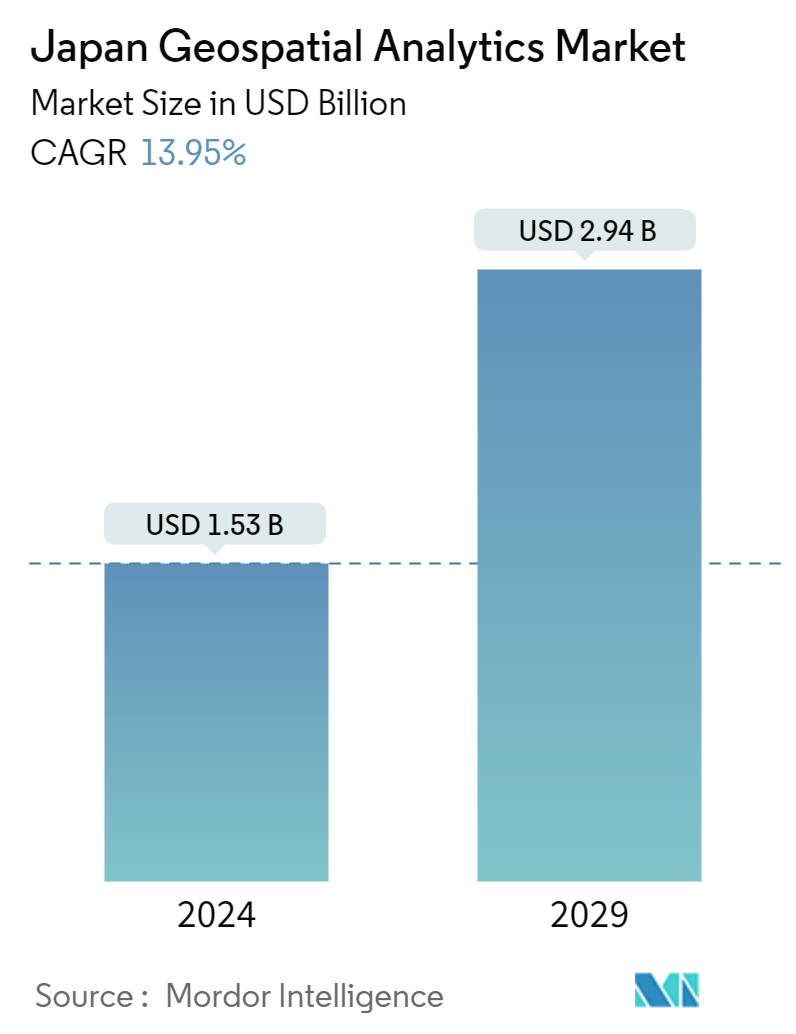Market Size of Japan Geospatial Analytics Industry

| Study Period | 2019 - 2029 |
| Base Year For Estimation | 2023 |
| Market Size (2024) | USD 1.53 Billion |
| Market Size (2029) | USD 2.94 Billion |
| CAGR (2024 - 2029) | 13.95 % |
| Market Concentration | Medium |
Major Players
*Disclaimer: Major Players sorted in no particular order |
Japan Geospatial Analytics Market Analysis
The Japan Geospatial Analytics Market size is estimated at USD 1.53 billion in 2024, and is expected to reach USD 2.94 billion by 2029, growing at a CAGR of 13.95% during the forecast period (2024-2029).
- Geospatial analytics is the process of gathering, manipulating, and displaying geographic information system (GIS) data and imagery, including GPS and satellite photographs. The Japanese geospatial analytics market was valued at USD 1.40 billion in the previous year, and it is expected to register a CAGR of 12.69%, reaching USD 2.81 billion by the next five years.
- The Japanese geospatial analytics market is experiencing significant growth due to the increasing adoption of smart city development projects. These initiatives leverage advanced technologies to enhance urban infrastructure, improve public services, and optimize resource management. As cities in Japan integrate geospatial analytics into their planning and operations, they better analyze spatial data, monitor environmental changes, and make informed decisions. This trend is expected to continue driving the market forward, offering numerous opportunities for innovation and investment in the coming years.
- For instance, the Tokyo Smart City Studio, a collaboration between the Georgia Institute of Technology and the University of Tokyo, is a research program that aims to develop a smart and ecologically sound community in Tokyo. The program uses geospatial analytics and other technologies to analyze and visualize urban planning, transportation, energy consumption, and more data.
- Also, the deployment of 5G technology is significantly enhancing the demand and growth of the geospatial analytics market in Japan. With the advent of 5G, the capabilities of geospatial analytics are expanding, offering faster data processing, improved accuracy, and real-time analytics. This technological advancement enables various sectors, including transportation, urban planning, and disaster management, to leverage geospatial data more effectively. As a result, the geospatial analytics market in Japan is experiencing robust growth, driven by the increased adoption of 5G technology.
- In Japan, while several factors propel the geospatial analytics market, high costs and operational challenges are significant constraints that impede its demand and growth. The high costs associated with implementing geospatial analytics solutions, including software, hardware, and skilled personnel, pose a substantial barrier for many organizations. Additionally, operational concerns such as data privacy issues, integration complexities, and the need for continuous updates and maintenance further hinder the market's expansion.
Japan Geospatial Analytics Industry Segmentation
Geospatial analytics is acquiring, manipulating, and displaying imagery and data from the geographic information system (GIS), such as satellite photos and GPS data. The specific identifiers of a street address and a zip code are used in geospatial data analytics. They are used to create geographic models and data visualizations for more accurate trend modeling and forecasting.
The scope of the study focuses on the market analysis segmented by type (surface analysis, network analysis, and geovisualization) and end-user vertical (agriculture, utility and communication, defense and intelligence, government, mining and natural resources, automotive and transportation, healthcare, real estate, and construction). The market sizes and forecasts are provided in terms of value (USD) for all the above segments.
| By Type | |
| Surface Analysis | |
| Network Analysis | |
| Geovisualization |
| By End-user Vertical | |
| Agricultural | |
| Utility and Communication | |
| Defense and Intelligence | |
| Government | |
| Mining and Natural Resources | |
| Automotive and Transportation | |
| Healthcare | |
| Real Estate and Construction | |
| Other End-user Verticals |
Japan Geospatial Analytics Market Size Summary
The Japanese geospatial analytics market is experiencing robust growth, driven by the increasing adoption of smart city projects and the deployment of 5G technology. These initiatives leverage advanced technologies to enhance urban infrastructure, improve public services, and optimize resource management. The integration of geospatial analytics into urban planning and operations allows for better analysis of spatial data, environmental monitoring, and informed decision-making. Despite the high costs and operational challenges associated with implementing geospatial analytics solutions, the market is poised for significant expansion, offering numerous opportunities for innovation and investment. The collaboration between academic institutions and industry players, such as the Tokyo Smart City Studio, exemplifies the potential of geospatial analytics in developing sustainable urban environments.
The market's growth is further bolstered by the increasing frequency of natural disasters in Japan, necessitating advanced geospatial analytics for disaster prediction, preparation, and mitigation. Government initiatives and policies aimed at disaster risk reduction, such as the National Resilience Program, drive the demand for these technologies. The integration of geospatial analytics with artificial intelligence and big data creates new opportunities for innovation in disaster management. Additionally, the popularity of location-based services, fueled by smartphone adoption and high-speed internet infrastructure, contributes significantly to market expansion. The Japanese government's promotion of geospatial information for public services and urban planning, along with the use of geospatial analytics in transportation, logistics, and retail, further supports market growth. Major players in the industry are focusing on strategic partnerships, acquisitions, and technological advancements to enhance their market presence and drive the development of advanced geospatial tools.
Japan Geospatial Analytics Market Size - Table of Contents
-
1. MARKET INSIGHTS
-
1.1 Market Overview
-
1.2 Industry Attractiveness - Porter's Five Forces Analysis
-
1.2.1 Threat of New Entrants
-
1.2.2 Bargaining Power of Buyers
-
1.2.3 Bargaining Power of Suppliers
-
1.2.4 Threat of Substitute Products
-
1.2.5 Intensity of Competitive Rivalry
-
-
1.3 Industry Value Chain Analysis
-
1.4 Impact of Macroeconomic Factors on Market
-
-
2. MARKET SEGMENTATION
-
2.1 By Type
-
2.1.1 Surface Analysis
-
2.1.2 Network Analysis
-
2.1.3 Geovisualization
-
-
2.2 By End-user Vertical
-
2.2.1 Agricultural
-
2.2.2 Utility and Communication
-
2.2.3 Defense and Intelligence
-
2.2.4 Government
-
2.2.5 Mining and Natural Resources
-
2.2.6 Automotive and Transportation
-
2.2.7 Healthcare
-
2.2.8 Real Estate and Construction
-
2.2.9 Other End-user Verticals
-
-
Japan Geospatial Analytics Market Size FAQs
How big is the Japan Geospatial Analytics Market?
The Japan Geospatial Analytics Market size is expected to reach USD 1.53 billion in 2024 and grow at a CAGR of 13.95% to reach USD 2.94 billion by 2029.
What is the current Japan Geospatial Analytics Market size?
In 2024, the Japan Geospatial Analytics Market size is expected to reach USD 1.53 billion.

